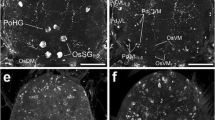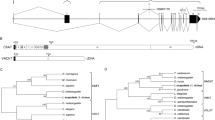Abstract
Immunocytochemistry was used to describe the distribution of serotonin-like immunoreactive (5HT-IR) neurons and neuronal processes in the central nervous system (CNS), the synganglion, of two ixodid tick species; the winter tick, Dermacentor albipictus and the lone star tick, Amblyomma americanum. 5HT-IR neurons were identified in the synganglion of both tick species. D. albipictus had a significantly higher number of 5HT-IR neurons than A. americanum. The labeling pattern and number of 5HT-IR neurons were significantly different between sexes in D. albipictus, but were not significantly different between sexes in A. americanum. 5HT-IR neurons that were located in the cortex of the synganglion projected processes into the neuropils, invading neuromeres in the supraesophageal ganglion including the protocerebrum, postero-dorsal, antero-dorsal and cheliceral neuromeres. In the subesophageal ganglion, dense 5HT-IR neuronal processes were found in the olfactory lobes, pedal, and opisthosomal neuromeres. Double-labeling with neurobiotin backfilled from the first leg damaged at the Haller’s organ revealed serotoninergic neuronal processes surrounding the glomeruli in the olfactory lobes. The high number of the 5HT-IR neurons and the extensive neuronal processes present in various regions of the synganglion suggest that serotonin plays a significant role in tick physiology.





Similar content being viewed by others
References
Binnington KC (1983) Ultrastructural identification of neurohemal sites in a tick: evidence that the dorsal complex may be a true endocrine gland. Tiss Cell 15:317–327
Binnington KC, Tatchell RJ (1973) The nervous system and neurosecretory cells of Boophilus microplus (Acarina, Ixodidae). Z Wiss Zool 185:193–206
Bowman AS, Sauer JR (2004) Tick salivary glands: function, physiology and future. Parasitology 129(Suppl):S67–S81
Chen A, Holmes SP, Pietrantonio PV (2004) Molecular cloning and functional expression of a serotonin receptor from the southern cattle tick, Boophilus microplus (Acari: Ixodidae). Insect Mol Biol 13:45–54
Chow YS, Wang CH (1974) Neurosecretory cells and their ultrastructures of Rhipicephalus sanguineus (Latreille) (Acarina: Ixodidae). Acta Arachnol 25:53–67
Coast GM, Orchard I, Phillips JE, Schooley DA (2002) Insect diuretic antidiuretic hormones. Adv Insect Physiol 29:273–280
Dacks AM, Nickel T, Mitchell BK (2003) An examination of serotonin and feeding in the flesh fly Neobellieria bullata (Sarcophagidae: Diptera). J Insect Behav 16:1–21
Dacks AM, Christensen TA, Hildebrand JG (2006) Phylogeny of a serotonin-immunoreactive neuron in the primary olfactory center of the insect brain. J Comp Neurol 498:727–746
Davis NT, Hildebrand JG, Homberg U, Agricola H-J, Teal PEA, Altstein M (1996) Neuroanatomy and immunocytochemistry of the median neuroendocrine cells of the subesophageal ganglion of the tobacco hawkmoth, Manduca sexta: immunoreactivities to PBAN and other neuropeptides. Microsc Res Tech 35:201–229
Dekeyser MA (2005) Acaricide mode of action. Pest Manag Sci 61:103–110
Dhanda V (1967) Changes in neurosecretory activity at different stages in the adult Hyalomma dromedarii Koch, 1844. Nature 214:508–509
Drummond RO (2004) Ticks and what you can do about them. Wilderness Press, Berkeley, California
Eichenberger G (1970) Das zentralnervensystem won Ornithodorus moubata (Murray), Ixodidae: Argasidae, und seine postembryonale Entwicklung. Acta Trop XXVII:15–53
Eisen Y, Warburg MR, Galun R (1973) Neurosecretory activity as related to feeding and oogenesis in the fowl-tick Argas persicus (Oken). Gen Comp Endocrinol 21:331–340
Fain JM, Berridge MJ (1979) Relationship between hormonal activation of phosphatidylinositol hydrolysis, fluid secretion and calcium flux in the blowfly salivary gland. Biochem J 178:45–58
Gabbay S, Warburg MR (1977) The diversity of neurosecretory cell types in the cave tick Ornithodoros tholozani. J Morphol 153:371–386
Gabe M (1955) Histological data on neurosecretion in arachnids. Arch Anat Microsc Morphol Exp 44:351–383
George JE, Davey RB, Pound JM (2002) Introduced ticks and tick-borne disease: the threat and approaches to eradication. Vet Clin Food Anim 18:401–416
Harrewijn P, Kayser H (1997) Pymetrozine, a fast-acting and selective inhibitor of aphid feeding. In-situ studies with electronic monitoring of feeding behaviour. Pestic Sci 49:130–140
Ioffe ID (1964) Distribution of neurosecretory cells in the central nervous system of Dermacentor pictus Herm. (Acarina, Chelicerata). Dokl Akad Nauk SSSR S Evoluts Morfol 154:229–232
Kloppenburg P, Hildebrand JG (1995) Neuromodulation by 5-hydroxytryptamine in the antennal lobe of the sphinx moth Manduca sexta. J Exp Biol 198:603–611
Kloppenburg P, Ferns D, Mercer AR (1999) Serotonin enhances central olfactory neuron responses to female sex pheromone in the male sphinx moth Manduca sexta. J Neurosci 19:8172–8181
Lange AB (2004) A neurohormonal role for serotonin in the control of locust oviducts. Arch Insect Biochem Physiol 56:179–190
Lange AB, Orchard I, Barrett FM (1989) Changes in haemolymph serotonin levels associated with feeding in the blood-sucking bug, Rhodnius prolixus. J Insect Phys 35:393–399
Li AY, Davey RB, Miller RJ, George JE (2003) Resistance to coumaphos and diazinon in Boophilus microplus (Acari: Ixodidae) and evidence for the involvement of an oxidative detoxification mechanism. J Med Entomol 40:482–490
Li AY, Davey RB, Miller RJ, George JE (2004) Detection and characterization of amitraz resistance in the Southern Cattle Tick, Boophilus microplus (Acari: Ixodidae). J Med Entomol 41:193–200
Li AY, Davey RB, Miller RJ, George JE (2005) Mode of inheritance of amitraz resistance in a Brazilian strain of the southern cattle tick, Boophilus microplus (Acari: Ixodidae). Exp Appl Acarol 37:183–198
McSwain JL, Tucker JS, Essenberg RC, Sauer JR (1989) Brain factor induced formation of inositol phosphates in tick salivary glands. Insect Biochem 19:343–350
Meola S (1970) Sensitive paraldehyde-fuschin technique for neurosecretory system of mosquitoes. Trans Am Microsc Soc 89:66–71
Mercer A, Hayashi J, Hildebrand JG (1995) Modulatory effects of 5-hydroxytryptamine on voltage-gated currents in cultured antennal lobe neurons of the sphinx moth Manduca sexta. J Exp Biol 198:613–627
Mercer A, Kloppenburg P, Hildebrand J (1996) Serotonin-induced changes in the excitability of cultured antennal-lobe neurons of the sphinx moth Manduca sexta. J Comp Physiol A178:21–31
Nässel DR (1988) Serotonin and serotonin-immunoreactive neurons in the nervous system of insects. Prog Neurobiol 30:1–85
Obenchain FD (1974a) Structure and anatomical relationships of the synganglion in the American dog tick, Dermacentor variabilis (Acari: Ixodidae). J Morphol 142:205–224
Obenchain FD (1974b) Neurosecretory system of the American dog tick, Dermacentor variabilis (Acari: Ixodidae). I. Diversity of cell types. J Morphol 142:433–446
Obenchain FD, Oliver Jr JH (1975) Neurosecretory system of the American dog tick, Dermacentor variabilis (Acari: Ixodidae). II. Distribution of secretory cell types, axonal pathways and putative neurohemal-neuroendocrine associations; comparative histological and anatomical implications. J Morphol 145:269–294
Paine SH, Kemp DH, Allen JR (1983) In vitro feeding of Dermacentor andersoni (Stiles): effects of histamine and other mediators. Parasitology 86:419–428
Pound JM, Oliver Jr JH (1982) Synganglial and neurosecretory morphology of female Ornithodoros parkeri (Cooley) (Acari: Argasidae). J Med Entomol 173:159–177
Prullage JB, Pound JM, Meola SM (1992) Synganglial morphology and neurosecretory centers of adults Amblyomma americanum (L.) (Acari: Ixodidae). J Med Entomol 29:1023–1034
Roshdy MA, Shourkey NM, Coons LB (1973) The subgenus Persicargas (Ixodoidea: Argasidae: Argas). 17. A neurohemal organ in A. (P.) arboreus Kaiser, Hoogstraal, and Kohls. J Parasitol 59:540–544
SAS Institute (1998) SAS/STAT user’s guide, release 6.03 edition. SAS Institute, Cary
Seyfarth E-A, Hammer K, Grünert U (1990a) Serotonin-like immunoreactivity in the CNS of spiders. Verh Dtsch Zool Ges 83:640 (text in German)
Seyfarth E-A, Hammer K, Grünert U (1990b) Serotonin—like immunoreactivity in the CNS of spiders. In: Elsner N, Roth G (eds) Brain—perception, cognition. Proceedings of the 18th Göttingen neurobiology conference. Thieme Verlag Stuttgart, New York, p 321
Schachtner J, Bräunig P (1993) The activity pattern of identified neurosecretory cells during feeding behavior in the locust. J Exp Biol 185:287–303
Sonenshine DE (1991) Biology of ticks, vol 1. Oxford University Press, New York, p 447
Steullet P, Guerin PM (1994) Identification of vertebrate volatiles stimulating olfactory receptors on tarsus I of the tick Amblyomma variegatum Fabricius (Ixodidae). I. Receptors within the Haller’s organ capsule. J Comp Physiol A 174:27–38
Szlendak E, Oliver Jr JH (1992) Anatomy of synganglia, including their neurosecretory regions, in unfed, virgin female Ixodes scapularis Say (Acari: Ixodidae). J Morphol 213:349–364
van Wijk M, Wadman WJ, Sabelis MW (2006) Morphology of the olfactory system in the predatory mite Phytoseiulus persimilis. Exp Appl Acarol 40:217–229
Zhu XX, Oliver Jr JH (1991) Immunocytochemical localization of an insulin-like substance in the synganglion of the tick Ornithodoros parkeri (Acari: Argasidae). Exp Appl Acarol 13:153–160
Zhu XX, Oliver Jr JH (2001) Cockroach allatostatin-like immunoreactivity in the synganglion of the American dog tick Dermacentor variabilis (Acari: Ixodidae). Exp Appl Acarol 25:1005–1013
Acknowledgements
We thank K. M. Collins, J. B. Welch, Z. Syed and two anonymous reviewers for critically reviewing this manuscript. We thank N. Davis for generously training N. A. H. in immunocytochemical methods; the RCMI Advanced Imaging Core Facility at University of Texas, San Antonio for use of the Zeiss LSM 510; and J. M. Pound for thoughtful discussion. We also thank D. Burchers for rearing ticks and technical support. N. A. H. is supported by a USDA, ARS, Postdoctoral Research Associate Program award to A. Y. L.
Author information
Authors and Affiliations
Corresponding authors
Additional information
This article reports the results of research only. Mention of a proprietary product does not constitute an endorsement or a recommendation by the USDA for its use.
The U.S. Government’s right to retain a non-exclusive, royalty free license in and to any copyright is acknowledged.
Rights and permissions
About this article
Cite this article
Hummel, N.A., Li, A.Y. & Witt, C.M. Serotonin-like immunoreactivity in the central nervous system of two ixodid tick species. Exp Appl Acarol 43, 265–278 (2007). https://doi.org/10.1007/s10493-007-9120-z
Received:
Accepted:
Published:
Issue Date:
DOI: https://doi.org/10.1007/s10493-007-9120-z




